
Psychology Tools therapy resources are carefully designed to support your clinical work, and perfect for psychotherapy practitioners and counselors of all stages. Explore our range of CBT worksheets, exercises, information handouts, self-help guides, audio therapy tools, and the Treatments That Work™ series. Translations are available in over 70 languages, and many of our resources are downloadable in multiple formats to suit your therapy style. Read more
See recommended resources Recent releases

Dissociation can be described as a shift of a person’s attention away from the present moment. When working with traumatized clients, this shift oft . https://www.psychologytools.com/resource/grounding-techniques-menu

Cognitive distortions (or ‘unhelpful thinking styles’) are ways that our thoughts become biased. Different cognitive biases are associated with di . https://www.psychologytools.com/resource/cognitive-distortions-unhelpful-thinking-styles-extended

Everyone experiences interpersonal hurts, such as acts of omission (e.g., being neglected) and acts of commission (e.g., intentional or unintentional . https://www.psychologytools.com/resource/forgiveness

The fight or flight response is an automatic physiological reaction to an event that is perceived as stressful or frightening. The perception of threa . https://www.psychologytools.com/resource/fight-or-flight-response

Everyone experiences hurts and transgressions. When an offence occurs, people often react with anger, fear, or sadness. When these responses persist, . https://www.psychologytools.com/resource/unforgiveness

Cognitive distortions (or ‘unhelpful thinking styles’) are ways that our thoughts become biased. Different cognitive biases are associated with di . https://www.psychologytools.com/resource/cognitive-distortions-unhelpful-thinking-styles-common

Communicating and acting assertively is an interpersonal skill that helps people to maintain healthy relationships, resolve interpersonal conflict, an . https://www.psychologytools.com/resource/assertive-communication

The window of tolerance concept was coined by Dan Siegel in his 1999 book The Developing Mind. Siegel proposes that everyone has a range of intensitie . https://www.psychologytools.com/resource/window-of-tolerance

A therapy blueprint is CBT tool which summarizes the work a therapist and patient have completed together. It represents the past (the problems, what . https://www.psychologytools.com/resource/therapy-blueprint-universal

Meaningful activity is value-driven. This ACT-informed worksheet explores the key domains of values and encourages clients to reflect upon what is imp . https://www.psychologytools.com/resource/values

Intolerance of uncertainty (IU) was first described in individuals suffering from Generalized Anxiety Disorder (GAD). Many behaviors associated with G . https://www.psychologytools.com/resource/embracing-uncertainty

Schema therapy posits that psychological difficulties stem from early maladaptive schemas (EMS) and clients’ characteristic responses to them, refer . https://www.psychologytools.com/resource/social-isolation

Values are the “principles for living” that capture what matters most to people. Elucidating values can serve many therapeutic functions, includin . https://www.psychologytools.com/resource/choosing-your-values
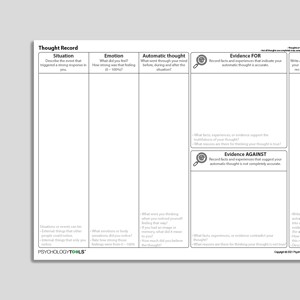
CBT Thought Records exist in multiple variants, depending on the needs and abilities of the client. This Thought Record (Evidence For And Against) is . https://www.psychologytools.com/resource/thought-record-evidence-for-and-against

Schema therapy posits that psychological difficulties stem from early maladaptive schemas (EMS) and clients’ characteristic responses to them, refer . https://www.psychologytools.com/resource/subjugation

Individuals who have experienced trama often find it difficult to stay within the 'window of tolerance'. Grounding techniques (which can be sensory/pe . https://www.psychologytools.com/resource/grounding-techniques

Schema therapy posits that psychological difficulties stem from early maladaptive schemas (EMS) and clients’ characteristic responses to them, refer . https://www.psychologytools.com/resource/insufficient-self-control

Uncertainty is a normal part of life – we can never be 100% sure about what will happen next. Many people feel good about uncertainty and live lives . https://www.psychologytools.com/resource/intolerance-of-uncertainty
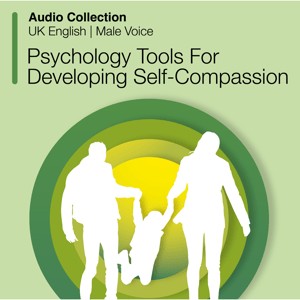
Psychology Tools For Developing Self-Compassion is an audio collection which guides clients through an empirically-supported programme of compassionat . https://www.psychologytools.com/resource/psychology-tools-for-developing-self-compassion-audio-collection

Cognitive behavioral models of obsessive compulsive disorder (OCD) suggest that it is the client’s interpretation of normal intrusive thoughts, imag . https://www.psychologytools.com/resource/obsessive-compulsive-disorder-ocd-formulation
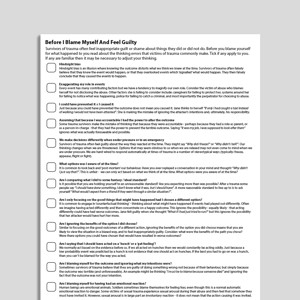
Guilt is a common post-traumatic reaction and is often the result of cognitive bias. This CBT worksheet explores common cognitive biases that have bee . https://www.psychologytools.com/resource/before-i-blame-myself-and-feel-guilty

Cognitive restructuring is an evidence-based intervention that involves identifying, evaluating, and modifying maladaptive cognitions, including negat . https://www.psychologytools.com/resource/prompts-for-challenging-your-negative-thinking

At the heart of Compassion Focused Therapy (CFT) is an evolutionary model of human motivational systems. Developed by Paul Gilbert it is a helpful len . https://www.psychologytools.com/resource/motivational-systems-emotional-regulation-systems
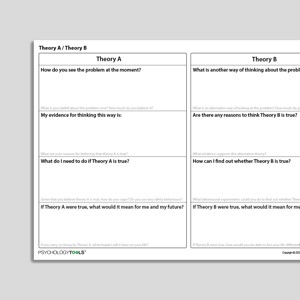
Human beings actively try to understand their world and what happens to them. However, these understanding can be inaccurate or unhelpful. Worse, unhe . https://www.psychologytools.com/resource/theorya-theoryb

Being able to communicate assertively is an essential skill for developing and maintaining healthy relationships and positive self-esteem. Individuals . https://www.psychologytools.com/resource/assertive-responses

Unmet emotional needs can give rise to early maladaptive schemas, and other forms of maladaptive coping. This Unmet Emotional Needs handout forms part . https://www.psychologytools.com/resource/unmet-emotional-needs

NOTE: Two improved versions of this resource are available here: Cognitive Distortions – Unhelpful Thinking Styles (Common) and Cognitive Disto . https://www.psychologytools.com/resource/unhelpful-thinking-styles-archived

Worry is a cognitive process that involves thinking about problems that might happen in a way that causes anxiety. Not all worry is problematic – we . https://www.psychologytools.com/resource/worry-flowchart

Case conceptualizations (formulations) help therapists and clients come to a shared understanding of a problem. This Cross Sectional Formulation explo . https://www.psychologytools.com/resource/cross-sectional-formulation

Helping clients to choose which activities to target during behavioral activation (BA) can be accomplished in a variety of ways: activity monitoring c . https://www.psychologytools.com/resource/activity-menu

Cognitive restructuring is an evidence-based intervention that involves identifying, evaluating, and modifying maladaptive cognitions, including negat . https://www.psychologytools.com/resource/examining-your-negative-thoughts

This Post-Traumatic Stress Disorder (PTSD) Formulation is designed for use in trauma-focused cognitive therapy for PTSD (CT-PTSD): an empirically supp . https://www.psychologytools.com/resource/ptsd-formulation

Fennell’s cognitive behavioral model of low self-esteem proposes that negative beliefs about the self are maintained by biased information processin . https://www.psychologytools.com/resource/low-self-esteem-formulation

The Psychology Tools For Relaxation Audio Collection is designed to help anyone experiencing stress or heightened physiological arousal. The audio col . https://www.psychologytools.com/resource/psychology-tools-for-relaxation-audio-collection
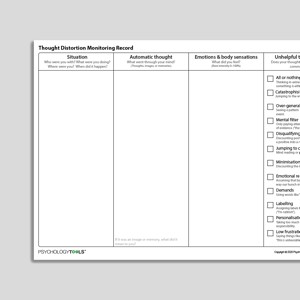
Thinking is often biased in particular ways and individuals often have their own characteristic patterns of bias. The Thought Distortion Monitoring Re . https://www.psychologytools.com/resource/thought-distortion-monitoring-record

Using Behavioral Activation To Overcome Depression is a guide written for clients who are currently depressed. It provides clear information about dep . https://www.psychologytools.com/resource/using-behavioral-activation-to-overcome-depression

Trauma can result in a wide variety of symptoms, experiences, and behaviors. As well as post-traumatic stress disorder (PTSD), prevalence rates of oth . https://www.psychologytools.com/resource/how-trauma-can-affect-you-cyp

Many clients find it helpful to recognize the range of actions that are motivated by different emotional states. This worksheet encourages clients to . https://www.psychologytools.com/resource/emotions-motivate-actions

Behavioral experiments allow individuals to test the validity of their beliefs and assumptions. They are a core experiential technique for therapeutic . https://www.psychologytools.com/resource/behavioral-experiment-portrait-format

Behavioral activation (BA) is an effective treatment for depression. Different behavioral activation protocols include a variety of treatment componen . https://www.psychologytools.com/resource/behavioral-activation-activity-diary

People suffering from social anxiety disorder (previously known as social phobia) experience persistent fear or anxiety concerning social or performan . https://www.psychologytools.com/resource/social-anxiety-formulation

Cognitive behavioral therapy (CBT) is fundamentally concerned with the meanings which people make of their experiences. The insight of the CBT model i . https://www.psychologytools.com/resource/what-is-cbt-worksheet-handout

Progressive relaxation training originated in the 1930’s as a treatment for tension and anxiety. Edmund Jacobsen developed a systematic and lengthy . https://www.psychologytools.com/resource/progressive-muscle-relaxation

Schema therapy posits that psychological difficulties stem from early maladaptive schemas (EMS) and clients’ characteristic responses to them, refer . https://www.psychologytools.com/resource/mistrust-abuse

Fair fighting is a collection of rules that individuals can use to manage conflict effectively, so that it is ‘fair’ and works towards a resolutio . https://www.psychologytools.com/resource/fair-fighting-rules-for-resolving-conflict

Human beings are programmed to respond automatically in a variety of ways to a threat including freezing, escaping, and dissociation. Traumatized indi . https://www.psychologytools.com/resource/responses-to-threat-freeze-appease-flight-fight

Cognitive behavioral therapy (CBT) describes three levels of cognition – automatic thoughts, assumptions, and core beliefs – which are influenced . https://www.psychologytools.com/resource/how-your-past-affects-your-present-cbt

Schema therapy posits that psychological difficulties stem from early maladaptive schemas (EMS) and clients’ characteristic responses to them, refer . https://www.psychologytools.com/resource/punitiveness

Health anxiety is characterized by a preoccupation with having or acquiring a serious illness, and a high level of anxiety about health. People with h . https://www.psychologytools.com/resource/health-anxiety-formulation

Mastery Of Your Anxiety And Worry comes in two volumes. This page is for the Workbook. Click on the following link to access the accompanying Therapis . https://www.psychologytools.com/resource/mastery-of-your-anxiety-and-worry-workbook
Treatments That Work™

Many people find it hard to label their emotional states or reactions. This information handout provides a list of emotions, categorizing them as basi . https://www.psychologytools.com/resource/emotions

Worry postponement ("worry time") is often prescribed as an exploratory or standalone intervention relatively early in the treatment of GAD, but . https://www.psychologytools.com/resource/worry-postponement
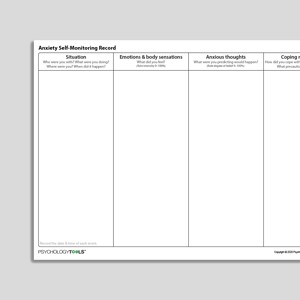
Developing self-monitoring skills teaches clients to systematically observe and record specific targets such as their own thoughts, body feelings, emo . https://www.psychologytools.com/resource/anxiety-self-monitoring-record

Values: Connecting To What Matters is a practical self-help guide which introduces the reader to a cornerstone of acceptance and commitment therapy (A . https://www.psychologytools.com/resource/values-connecting-to-what-matters-full-guide

Practising Relaxed Breathing serves to reduce physiological arousal and can be an excellent grounding technique. This client information handout descr . https://www.psychologytools.com/resource/relaxed-breathing

The “What Keeps It Going?” series is a set of one-page diagrams explaining how common mental health conditions are maintained. Friendly and concis . https://www.psychologytools.com/resource/what-keeps-generalized-anxiety-and-worry-going

Schema therapy posits that psychological difficulties stem from early maladaptive schemas (EMS) and peoples’ characteristic responses to them, refer . https://www.psychologytools.com/resource/what-are-schemas

Some sleep experts recommend that sleep hygiene issues be attended to as one component of treatment for poor sleep. This sleep hygiene information wor . https://www.psychologytools.com/resource/guidelines-for-better-sleep

Values are the “principles for living” that capture what matters most to people. Elucidating values can serve many therapeutic functions, such as . https://www.psychologytools.com/resource/valued-domains

The aim of a formulation is to help the client and therapist to come to a shared understanding of what a client is experiencing. The Panic Formulation . https://www.psychologytools.com/resource/panic-formulation

Self-monitoring of thoughts, feelings and symptoms is an essential skill for clients engaged in cognitive behavioral therapy (CBT). Clients will find . https://www.psychologytools.com/resource/ocd-diary

Schema therapy posits that psychological difficulties stem from early maladaptive schemas (EMS) and clients’ characteristic responses to them, refer . https://www.psychologytools.com/resource/pessimism

Schema therapy posits that psychological difficulties stem from early maladaptive schemas (EMS) and clients’ characteristic responses to them, refer . https://www.psychologytools.com/resource/abandonment

The Fear Ladder is a tool for exploring and ranking the contexts or situations in which a client experiences fear. It is designed to help the client a . https://www.psychologytools.com/resource/fear-ladder

The Self-Blame information handout forms part of the cognitive distortions series, designed to help clients and therapists to work more effectively wi . https://www.psychologytools.com/resource/self-blame

Exposure And Response Prevention (ERP, EX/RP) is an effective treatment for obsessive compulsive disorder (OCD). This CBT worksheet guides therapists . https://www.psychologytools.com/resource/exposure-and-response-prevention

Schema therapy posits that psychological difficulties stem from early maladaptive schemas (EMS) and clients’ characteristic responses to them, refer . https://www.psychologytools.com/resource/coping-styles-and-responses-schema-therapy
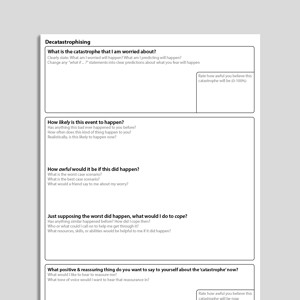
Catastrophic thinking (magnification) is characteristic of many anxiety problems. This CBT worksheet for decatastrophizing is a tool for cognitive res . https://www.psychologytools.com/resource/decatastrophizing

Our ‘Understanding…’ series is a collection of psychoeducation guides for common mental health conditions. Friendly and explanatory, they are co . https://www.psychologytools.com/resource/understanding-generalized-anxiety-and-worry

Traumatic events are shocking and it is normal to feel overwhelmed. Not everybody reacts in the same way though and there is no ‘right’ way to res . https://www.psychologytools.com/resource/reactions-to-trauma
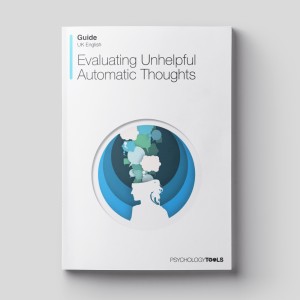
The Evaluating Unhelpful Automatic Thoughts guide is written for clients who struggle with negative automatic thoughts. It provides a comprehensive in . https://www.psychologytools.com/resource/evaluating-unhelpful-automatic-thoughts
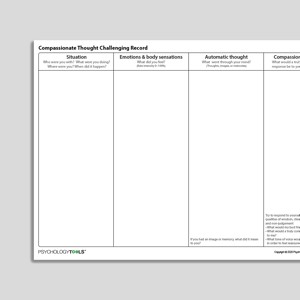
Thought challenging records are commonly used in CBT to help people to evaluate their negative automatic thoughts for accuracy and bias. This Compassi . https://www.psychologytools.com/resource/compassionate-thought-challenging-record

The “What Keeps It Going?” series is a set of one-page diagrams explaining how common mental health conditions are maintained. Friendly and concis . https://www.psychologytools.com/resource/what-keeps-depression-going

Self-monitoring of thoughts, feelings, and symptoms is an essential skill in cognitive behavioral therapy (CBT). This Simple Thought Record is an exce . https://www.psychologytools.com/resource/simple-thought-record
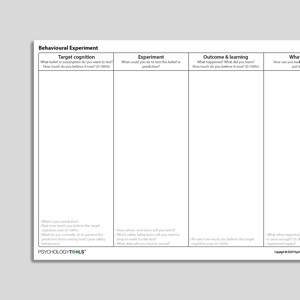
Behavioral experiments are planned experiential activities to test the validity of a belief. They are one of the most powerful techniques available to . https://www.psychologytools.com/resource/behavioral-experiment

The Habituation information sheets are designed to help clinicians to explain the concept of habituation and its role in exposure therapy. The handout . https://www.psychologytools.com/resource/habituation

Rumination and repetitive thought is a transdiagnostic maintenance process underpinning a range of difficulties. This information sheet explores the c . https://www.psychologytools.com/resource/what-is-rumination
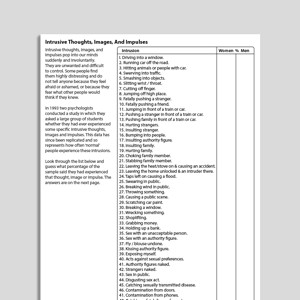
Intrusive Thoughts, Images, And Impulses that are experienced as distressing are a feature of obsessive compulsive disorder (OCD). They are also a com . https://www.psychologytools.com/resource/intrusive-thoughts-images-and-impulses

Schema therapy posits that psychological difficulties stem from early maladaptive schemas (EMS) and clients’ characteristic responses to them, refer . https://www.psychologytools.com/resource/failure-to-achieve

Case conceptualizations (formulations) help therapists and clients come to a shared understanding of a problem. This longitudinal case formulation wor . https://www.psychologytools.com/resource/longitudinal-formulation-2

The Unified Protocol for Transdiagnostic Treatment of Emotional Disorders (Second Edition) comes in two volumes. This page is for the Client Workbook. . https://www.psychologytools.com/resource/unified-protocol-for-transdiagnostic-treatment-of-emotional-disorders-second-edition-client-workbook
Treatments That Work™

Mastery Of Your Anxiety And Panic comes in two volumes. This page is for the Workbook. Click on the following link to access the accompanying Therapis . https://www.psychologytools.com/resource/mastery-of-your-anxiety-and-panic-workbook
Treatments That Work™

The Psychology Tools For Mindfulness Audio Collection is the perfect way to introduce your clients to the practice of mindfulness. Developed by a clin . https://www.psychologytools.com/resource/psychology-tools-for-mindfulness-audio-collection

Cognitive behavioral therapy (CBT) describes three levels of cognition: automatic thoughts, assumptions, and core beliefs. While CBT therapists do not . https://www.psychologytools.com/resource/uncovering-your-deeper-beliefs

The Pie Chart - Responsibility exercise is designed to guide clients through the process of clarifying and re-evaluating their responsibility for nega . https://www.psychologytools.com/resource/pie-chart-responsibility

Cognitive behavioral therapy (CBT) is an effective treatment for a wide variety of mental and physical health conditions. This information handout des . https://www.psychologytools.com/resource/overview-of-cbt

Worrying is a form of thinking about the future, defined as thinking about future events in a way that leaves you feeling anxious or apprehensive. Cli . https://www.psychologytools.com/resource/what-is-worry

Case conceptualizations (formulations) help therapists and clients come to a shared understanding of a problem. This simple CBT formulation worksheet . https://www.psychologytools.com/resource/friendly-formulation

The "What Keeps It Going?" series is a set of one-page diagrams explaining how common mental health conditions are maintained. Friendly and concise, t . https://www.psychologytools.com/resource/what-keeps-obsessive-compulsive-disorder-ocd-going

Schema therapy posits that many longstanding psychological difficulties stem from unmet core emotional needs, the early maladaptive schemas (EMS) they . https://www.psychologytools.com/resource/how-your-past-affects-your-present-schema-therapy

Schema therapy posits that psychological difficulties stem from early maladaptive schemas (EMS) and clients’ characteristic responses to them, refer . https://www.psychologytools.com/resource/emotional-deprivation
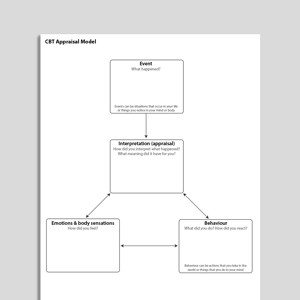
The CBT Appraisal Model worksheet is a transdiagnostic formulation tool. The centrality of appraisals underpins all of the disorder-specific cognitive . https://www.psychologytools.com/resource/cbt-appraisal-model

Our ‘Understanding…’ series is a collection of psychoeducation guides for common mental health conditions. Friendly and explanatory, they are . https://www.psychologytools.com/resource/understanding-obsessive-compulsive-disorder-ocd

The Types Of Dissociation information handout is designed for clients who have experienced trauma and describes dissociation using accessible terminol . https://www.psychologytools.com/resource/types-of-dissociation

Our ‘Understanding…’ series is a collection of psychoeducation guides for common mental health conditions. Friendly and explanatory, they are co . https://www.psychologytools.com/resource/understanding-low-self-esteem

The CBT Thought Record is an essential tool in cognitive behavioral therapy. Thought challenging records help people to evaluate their negative automa . https://www.psychologytools.com/resource/cbt-thought-record-portrait

Behavioral activation (BA) is a structured psychotherapeutic approach effective for a range of disorders, including depression (Ekers et al., 2014), a . https://www.psychologytools.com/resource/changing-avoidance-behavioral-activation

Important properties of trauma memories include involuntary recall, 'nowness', vividness, and immutability. People who have experienced trauma report . https://www.psychologytools.com/resource/properties-of-trauma-memories

Some sleep experts recommend that sleep hygiene issues be attended to as one component of treatment for poor sleep. This sleep hygiene worksheet is in . https://www.psychologytools.com/resource/checklist-for-better-sleep

Low self-esteem is characterized as a negative sense of the self and co-occurs with many other mental health problems. Although not formally represent . https://www.psychologytools.com/resource/cognitive-behavioral-model-of-low-self-esteem-fennell-1997
Psychology Tools develops and publishes evidence-based psychotherapy resources and tools for mental health professionals. Our online library gives you access to everything you need to deliver more effective therapy and support your practice. With a wide range of topics and resource types covered, you can feel confident knowing you’ll always have a range of accessible and effective materials to support your clients, whatever challenges they are facing, whatever stage you are at, and however you work.
Choose from assessment and case formulations to psychoeducation, interventions and skills development, CBT worksheets, exercises, and much more. Our resources include detailed therapist guidance, references and instructions, so they are equally suitable for those with less experience but who want to expand their practice. Each resource explains how to work with the material most effectively, and how to use it with clients.
Psychology Tools is used by thousands of professionals all over the world as a key part of their practice and preparation, and our resources are designed to be used with clients who experience psychological difficulties or distress. Professionals who use our resources include:
Psychology Tools resources are perfect for individuals, teams and students, whatever their preferred modality, or career stage.
Psychology Tools offers a range of relatable, engaging, and evidence-based resources to ensure that your clients get the most out of therapy or counseling. Each resource has been carefully designed with accessibility in mind and is informed by best practice guidelines and the latest scientific research.
Therapeutic exercises are used in many evidence-based psychotherapies including cognitive behavioral therapy, rational emotive behavior therapy, compassion-focused therapy, schema therapy, emotion-focused therapy, systemic family-based therapies, and several others.
Therapists and counselors benefit from incorporating exercises into their work. They can be used to:
Psychology Tools offers a variety of exercises that you can use with your clients as a part of therapy or counseling. These interventions can be incorporated into your sessions, assigned as homework tasks, or used stand-alone interventions. Many of our exercises are either evidence-based (meaning they have been shown to effectively treat certain difficulties) or evidence-derived (meaning they form part of a treatment program that has been shown to effectively treat certain difficulties).
The exercises available at Psychology Tools have a variety of applications. You can use them to:
Psychology Tools exercises have been developed with practicality and convenience in mind. Most exercises include simple step-by-step instructions so that clients can use them independently or with the support of their therapist or counselor. In addition, therapist guidance is available for each exercise, which includes a detailed description of the task, relevant background information, an overview of its aims and potential uses in therapy, and simple instructions for its delivery. A comprehensive list of references is also provided so that you can access key studies and further your understanding of each exercise’s applications in psychotherapy.
Did you know that 40 – 80% of medical information is immediately forgotten by patients (Kessels, 2003)? The same is probably true of therapy and counseling, so clients will almost always benefit from having access to additional written information.
Psychology Tools information handouts provide clear, concise, and reliable information, which will empower your clients to take an active role in their treatment. Learning about their mental health, helpful strategies and techniques, and other psychoeducation topics helps clients better understand and overcome their difficulties. Moreover, clients who understand the process and content of therapy are more likely to invest in the process and commit to making positive changes.
Psychology Tools information handouts can help your clients:
Our illustrated information handouts cover a wide variety topics. Each has been informed by scientific evidence, best practice guidelines, and expert opinion, ensuring they are both credible and consistent with evidence-based therapies. Topics featured among these resources include:
Each information handout comes with guidance written specifically for therapists and counselors. It provides suggestions for introducing psychoeducation topics, facilitating helpful discussions related to the handout, and ensuring the content is relevant to your clients.
Worksheets are a core ingredient of many evidence-based therapies such as CBT. Our worksheets take many forms (e.g., diaries, diagrams, activity planners, records, and questionnaires) and can be used throughout the course of therapy.
How you incorporate worksheets into therapy or counselling depends on each client’s difficulties, goals, and stage of recovery. You can use them to:
Clients also benefit from using worksheets. These tools can help them:
Psychology Tools offers a wide variety of worksheets. They include general forms that are widely applicable, disorder-specific worksheets, and logs that are used in specific therapies such as CBT, schema therapy, and compassion-focused therapy. These resources are typically available in editable or fillable formats, so that they can be tailored to your client’s needs and used in a flexible manner.
People want clear guidance on mental health, whether for themselves or a loved one.
Our ‘Understanding…’ series is designed to introduce common mental health difficulties such as depression, PTSD, or social anxiety. Each of these guides uses a clear and accessible structure so that readers can understand them without any prior therapy knowledge. Topics addressed in each guide include:
Other guides address important topics such as trauma and dissociation, or the effects of perfectionism. They usually contain a mixture of psychoeducation, practical exercises and skills development. They promote knowledge, optimism, and positive action related to these difficulties, and have been informed by current research and evidence-based treatments, ensuring they are consistent with best practices.
Therapists can use Psychology Tools guides in several ways:
Each guide contains informative illustrations, practical examples, and simple instructions so that clients can easily relate to the content and apply it to their difficulties.
Audio exercises are a particularly convenient and engaging way help your clients and can add variety to your therapeutic toolkit. Psychology Tools audio resources can help your clients:
A variety of audio resources are available at Psychology Tools. Each one has been developed and recorded by highly experienced clinical psychologists and can be easily integrated into your therapeutic practice. Audio collections include:
Many of these audio resources are widely applicable (e.g., mindfulness-based tools), although problem-specific resources are also available (e.g., tools for overcoming PTSD). You can use these tools:
Authored by leading psychologists including David Barlow, Michelle Craske, and Edna Foa, Treatments That Work™ is a series of workbooks based on the principles of cognitive behavioral therapy (CBT). Each pair of books in the series – therapist guide and workbook – contains step by step procedures for delivering evidence-based psychological interventions. Clinical illustrations and worksheets are provided throughout.
You can use these workbooks:
Each book is available to download chapter-by-chapter, and Psychology Tools members with a currently active subscription to our ‘Complete’ plan are licensed to share copies with their clients.
We work hard to keep all resources up to date, so we regularly review and update our library. However, we understand that you might get used to a certain version of a resource as part of your workflow. Instead of removing older versions, we keep some in our archive so that you can still access them if you want to. We also clearly explain if an improved version is available, so you can choose which you prefer.
As well as many topic-specific resources, we also publish a variety of ranges and series.
Did you know that Psychology Tools has the largest online, searchable library of multilingual therapy resources? We aim to make our resources accessible to everyone. With over 3500 resources across 70 languages, you can give clients resources in their native language, enabling a deeper understanding and engagement with the treatment process. Translations are carried out by specially selected professional translators with experience of psychology, and our pool of volunteer mental health professionals. We also make sure that the resource design is the same for each translated resource so that you can be confident you know what section you are looking at, even if you don’t speak the language.
Simply find the resource you want to use, then explore which languages that resource is available in, or you can see all the resources available in a particular language by using our search filters.
People work in different ways. Our formats are designed to reflect that, so you can choose the style that suits how you and your client want to work. Psychology Tools resources are perfectly formatted to work whether you practice face to face, remotely, or use a blended approach.
Our resources are informed by evidence-based treatments, best practice guidelines, and the latest published research. They are written by highly experienced therapists and experts in mental health, ensuring they are effective and as up to date as possible. In addition, every resource goes through a rigorous peer review process to confirm they are accurate and easy to use.
Each resource is designed with both clients’ and therapists’ needs in mind. For clients, that means using clear, user-friendly language, as well as plenty of visual and case examples, illustrations, diagrams and vignettes that readers can relate to. They include information on how the resource can help them, how they should use it, and other useful tips.
We also include useful information and descriptions for clinicians to help them use the resource most effectively. The therapist versions of each resource contain therapist guidance, prompts, instructions, and full references. They outline how the resource can be used and what types of problems it could be helpful for.
This page is where you can explore all the resources in the Psychology Tools library. The different search filters on the left-hand side enable you to customize your search, depending on what you need. Materials are organized by resource type, problem, and therapy tool, though you can also filter by language or use the search box. You can find more detailed instructions for how to find resources here.
If you have a paid Psychology Tools membership, you are licensed to share resources with clients in the course of your professional work. You can even email resources (even large audio collections) directly to your clients from our website. All emails are secure and encrypted, so it is a quick and easy way to save you time and facilitate clients’ self-practice.
We have a wide range of ‘How-to’ guides and an FAQ in our help centre, which answers questions on how to use the library and tools, such as ‘How do I download resources?’ or ‘How do I email resources to my clients directly from the website?’.
Kessels, R. P. C. (2003). Patients’ memory for medical information. Journal of the Royal Society of Medicine, 96, 219-222.